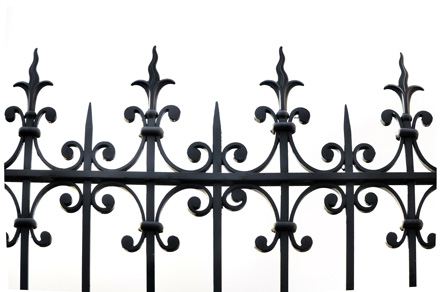Ironwork in buildings
Iron is the chemical element most commonly found on Earth by mass, forming much of the Earth’s outer and inner core. On the Periodic Table it has the symbol ‘Fe’ and atomic number 26. Pure iron is relatively soft but it is significantly hardened and strengthened during the smelting process by impurities such as carbon.
The term 'ironwork' refers to any architectural component or feature of a building, principally used for decorative purposes, that is made of iron.
While the use of iron for building purposes dates back to early civilisations, its use for decoration became more widespread between the 16th and 19th centuries. Ironwork began to be used during the medieval period for defensive purposes, but became more ornate and decorative in the Baroque and Rococo architectural periods, particularly for:
The two main types of ironwork are:
Wrought iron is a very low carbon metal made by intensive hand work using small scale production methods. The term 'cast iron' refers to a range of iron-carbon alloys, with a carbon content that is typically between 2 and 4%. Cast iron is manufactured by re-melting pig iron along with quantities of limestone, silicon and carbon (and sometimes scrap steel).
The term ‘ironworks’ refers to a place where iron is smelted or where iron products are manufactured.
NB the term ironwork can also be used to refer to items such as manhole covers, drain covers and so on used in the construction of highways.
[edit] Related articles on Designing Buildings Wiki
- Aluminium.
- Cast iron.
- Coal holes, pavement lights, kerbs and utilities and wood-block paving.
- Code of Practice for Ironwork Systems Installation and Refurbishment.
- Conservation of Architectural Ironwork.
- Difference between cast iron and wrought iron.
- Failure of cast iron beams.
- Iron.
- Metal.
- Railings.
- Steel.
- Wrought iron.
- Wrought iron spindles for external stairs.
Featured articles and news
International Electrician Day, 10 June 2025
Celebrating the role of electrical engineers from André-Marie Amperè, today and for the future.
New guide for clients launched at Houses of Parliament
'There has never been a more important time for clients to step up and ...ask the right questions'
The impact of recycled slate tiles
Innovation across the decades.
EPC changes for existing buildings
Changes and their context as the new RdSAP methodology comes into use from 15 June.
Skills England publishes Sector skills needs assessments
Priority areas relating to the built environment highlighted and described in brief.
BSRIA HVAC Market Watch - May 2025 Edition
Heat Pump Market Outlook: Policy, Performance & Refrigerant Trends for 2025–2028.
Committing to EDI in construction with CIOB
Built Environment professional bodies deepen commitment to EDI with two new signatories: CIAT and CICES.
Government Grenfell progress report at a glance
Line by line recomendation overview, with links to more details.
An engaging and lively review of his professional life.
Sustainable heating for listed buildings
A problem that needs to be approached intelligently.
50th Golden anniversary ECA Edmundson apprentice award
Deadline for entries has been extended to Friday 27 June, so don't miss out!
CIAT at the London Festival of Architecture
Designing for Everyone: Breaking Barriers in Inclusive Architecture.
Mixed reactions to apprenticeship and skills reform 2025
A 'welcome shift' for some and a 'backwards step' for others.
Licensing construction in the UK
As the latest report and proposal to licence builders reaches Parliament.
Building Safety Alliance golden thread guidance
Extensive excel checklist of information with guidance document freely accessible.
Fair Payment Code and other payment initiatives
For fair and late payments, need to work together to add value.
Pre-planning delivery programmes and delay penalties
Proposed for housebuilders in government reform: Speeding Up Build Out.
High street health: converting a building for healthcare uses
The benefits of health centres acting as new anchor sites in the high street.

























